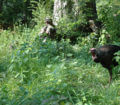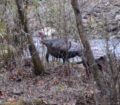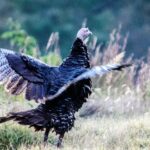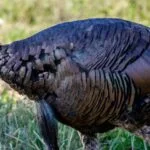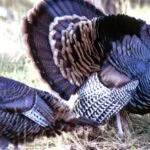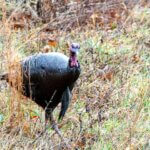Editor’s Note: Wild turkeys have their own vocabulary. Although scientists and hunters attempt to explain the vocabulary of the wild turkey, their statements and conclusions may be contradictory. Not until someone teaches a turkey to speak English will we find out exactly what each sound means.
* Early-Season Gobblers:
The term, early-season gobblers, means different things in various parts of the country. In states with only a 1-week turkey season, there’s neither an early nor a late season. There’s only, “the season.” In other states, the season begins around March 15 and runs until the end of April, or in some instances may start in May and continue through the first week in June. Often the toms won’t be gobbling during the first part of the season.
Therefore, let’s define “early season” as the time of the year just prior to the mating season. Although toms may be gobbling, they probably haven’t set-up their territories or bred any hens. This early season may be the most-difficult time of the year to call and bag a longbeard. The juvenile males, which are commonly referred to as jakes, will come to hen calls. But the older toms are usually reluctant to gobble.
So, during the early part of the season, woodsmanship plays a greater role in the turkey hunter’s success than his ability to call a turkey. By using the term, woodsmanship, I’m referring to the hunter’s knowledge of the woods and the turkey he’s hunting. A successful turkey hunter with woodsmanship skills consistently can bag a gobbler without using a call. This type of hunter learns everything he can about gobblers by watching where they roost and strut, and noting what fields they like to frequent. Generally, this turkey chaser also will know where a specific turkey is at throughout the day. Therefore, when the time comes for him or her to take that turkey, he simply sets-up an ambush along the route the gobbler normally travels. When a tom isn’t gobbling in the early season, determining his roost tree, strutting grounds and feeding sites can mean the difference between success and failure.
After the hens have started to go to their nests, hunting late in the morning may be the most-productive time. Late in the season, a hen usually will meet her gobbler as soon as he flies down off the roost. She’ll remain with him for an hour or two after daylight, and by 9:00 or 10:00 am will slip away to return to her nest.
To successfully hunt a gobbler, we must realize what’s driving his actions. When the tom lifts out of the tree in the morning and has all those beautiful hens just waiting for his services, he feels as though he’s the most desirable male in the world. He gets all puffed-up, struts his feathers and believes he’s a great lover.
But in the late season, come mid-morning, this world’s greatest lover finds himself alone. Not only does he not have a hen to mate, he doesn’t have any company. He’s by himself and brokenhearted. By that time of the morning, a gobbler is generally willing to talk to and pay a visit to any hen in the woods. So, if you’re in the woods when the tom’s in that frame of mind, there’s a good chance you can carry a tom home.
* The Late, Late Season:
The late, late season is when the hens are on the nest and can care less about the gobblers. However, toms are holding-out hope for an opportunity to breed one more hen. By this time, most gobblers have been well-educated by hunters. So, at the first sound of a hunter’s aggressive call, the gobbler may walk-off without ever making a sound.
However, if the turkey hears some soft clucks, yelps and purrs that he thinks come from a contented hen that has decided to be bred one more time, he may go quickly to her. Usually, gobblers in the late, late season won’t respond to any type of calling. That means the hunter must once again rely on his woodsmanship to set-up along the route that the bird normally follows every day.
* River-Bottom Swamps:
When I’m hunting river-bottom swamps, I begin the day with the understanding that I will get wet. I carry with me a boot dryer, extra boots and several sets of camouflage to my hunting club, since I assume I’ll either wade a creek, fall-in a mud hole or get rained-on during my stay.
 Sometimes, you’ll hear a turkey gobble on the other side of the slough or creek. Although some hunters may have called a bird across water, that scenario doesn’t happen often. The best technique to take a turkey that’s across the water from you is to wade the water and get on the same side as the bird. Turkeys will wade in water that’s not too deep, but they generally prefer not to wade water. The easier you can make the route from where he is to where you are, the more likely you are to bag the bird.
Sometimes, you’ll hear a turkey gobble on the other side of the slough or creek. Although some hunters may have called a bird across water, that scenario doesn’t happen often. The best technique to take a turkey that’s across the water from you is to wade the water and get on the same side as the bird. Turkeys will wade in water that’s not too deep, but they generally prefer not to wade water. The easier you can make the route from where he is to where you are, the more likely you are to bag the bird.
Three-other factors that contribute for the swamp hunter’s success or failure are mosquitoes, ticks and redbugs. Each of these has the potential to make a man with a will of steel flinch, squint and/or move when a turkey’s looking at him. Even when the tom’s standing at 30 yards, and the hunter is looking-down the barrel of the shotgun with the bead superimposed on the bird’s neck, a mosquito buzzing in the hunter’s ear or a tick crawling-up his back can break his concentration.
The simplest solution to this problem is to use 100-percent Deet insect repellent. But, remember that the insect repellent you put on before daylight may have washed off after you’ve waded the first stretch of flooded timber. So, carry insect repellent with you at all times, and reapply it after you come out of the water. The good news about hunting swamp turkeys is that the hunter can move more quietly through the water than the woods. He may move even closer to the bird before he begins to call.
* Deserts:
In some areas where turkeys have a vast amount of green grasses and shrubs, a large percentage of the water they need comes from the vegetation they eat. However, in dry, arid regions like the desert country in parts of the West, the only source of water that the turkey has is stock tanks and ponds. Since water is just as critical for the birds to survive as food, setting-up around stock tanks and ponds is an excellent way to locate and harvest desert turkeys. Something else that’s important to desert turkey is shade. When desert birds aren’t eating or drinking, they’re usually staying in the shade. Hunt around food, water and shade or the routes a tom will travel to reach these places.
Desert turkey hunters also learn that Rio Grande turkeys have two gears: stop and trot. Eastern birds walk from place to place and will fly or run only when alarmed. But the Rio Grande desert birds either sit tight or trot to reach a certain spot. Therefore, when you hear a Rio Grande turkey that’s not around food, water or shade gobble, he may be 1/2-mile away before you hear him again. Too, the sound of a gobble carries much farther in the desert than in mountainous areas and the woods of the East. Although a tom may gobble from 1/2-mile away, he may sound as close as only 100 yards away. In deserts, hunters may hear 40-50 toms gobbling in one morning. However, many of these gobblers are a mile or more away.
 Another critical factor to successfully hunt desert turkeys is the hunter’s ability to find a place from which to call. When a turkey gobbles in the East, the hunter usually can sit-down next to a tree that’s wider than his shoulders and be well-camouflaged. However, on the desert where there are few trees, locating anything high-enough to hide behind can be tough. One Rio Grande turkey I took in Texas was called up to an abandoned calf feeder. The feeder was between the turkey and a stock tank, and it was the only vertical relief for about 1/4-mile in all directions. If you’re accustomed to hunting eastern turkeys, you soon will discover that there’s much to learn about hunting western turkeys. However, desert turkeys may come to calling easier than eastern birds. Since western hunters traditionally bag gobblers with rifles, many desert turkeys rarely have heard calling by hunters.
Another critical factor to successfully hunt desert turkeys is the hunter’s ability to find a place from which to call. When a turkey gobbles in the East, the hunter usually can sit-down next to a tree that’s wider than his shoulders and be well-camouflaged. However, on the desert where there are few trees, locating anything high-enough to hide behind can be tough. One Rio Grande turkey I took in Texas was called up to an abandoned calf feeder. The feeder was between the turkey and a stock tank, and it was the only vertical relief for about 1/4-mile in all directions. If you’re accustomed to hunting eastern turkeys, you soon will discover that there’s much to learn about hunting western turkeys. However, desert turkeys may come to calling easier than eastern birds. Since western hunters traditionally bag gobblers with rifles, many desert turkeys rarely have heard calling by hunters.
* Western Mountain Turkeys:
When I hunted Merriam turkeys in the Rocky Mountains of New Mexico, I learned that I had been lied to all my life. Everyone had said Merriam gobblers were easy to hunt. The Merriam birds did respond to calls much-more readily than eastern turkeys. But hunting in the mountains at 8,000 feet above sea level wasn’t an easy task for a flatlander like myself.
I never realized the difference in hunting at high altitudes, until I tried to run-up a mountain the first morning. After 50 yards, I felt like the biggest gorilla in Africa was sitting on my chest. The muscles in my lungs were screaming for air, despite the fact that I had turkey hunted almost every day for 6 weeks, walking 6 to 10 miles per day. Some 30 yards up the mountain, my hunting companion whispered loudly, “Come on, John, let’s go.” Mountain turkeys seem to prefer walking over a mountain rather than down a valley. For someone unaccustomed to hunting at high altitudes, conditioning plays a major role in your ability to perform during a hunt.
To learn more about turkey hunting, check out John E. Phillips’ print, Audible, Kindle and Nook turkey books at https://johninthewild.com/books/#turkey and at www.barnesandnoble.com. You also can download a free Kindle app that enables you to read the book on your iPad, computer or SmartPhone. You can learn more about calling turkeys by going to johninthewild.com/audio-files/ for audio turkey tapes to purchase of Lovett Williams, Rob Keck and Chris Kirby, available for download to your SmartPhone, tablet or computer. For a free copy of John E. Phillips’ “The Turkey Gobbler Getter Manual,” go to https://johninthewild.com/free-books/ to download.

